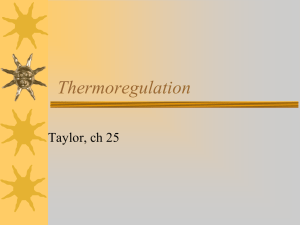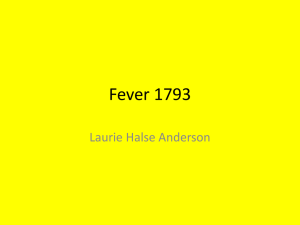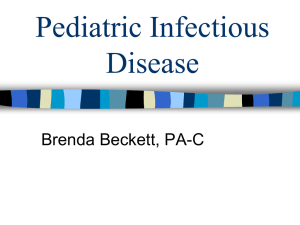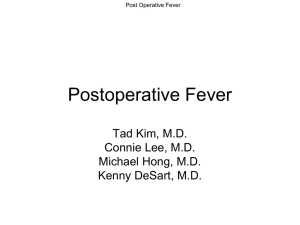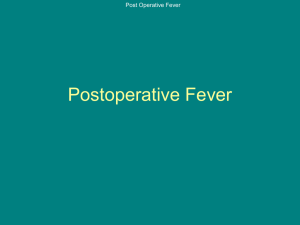Patologická fyziológia
advertisement
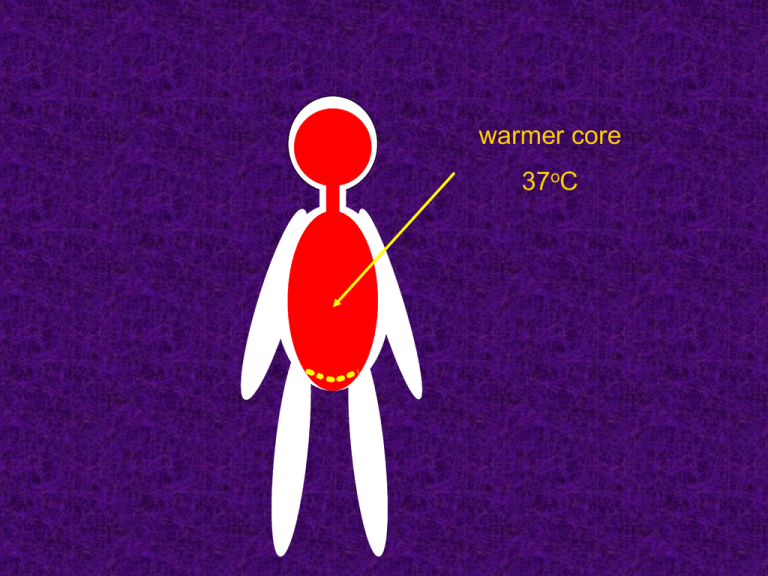
warmer core 37oC central thermoreceptors hypotalamus, spinal cord perpheral (skin) thermoreceptors centre of thermoregulation hypotalamus TSH-RH TSH T3, T4 ANS - sympathicus somatomotor NS metabolism brown adipose tissue sweat glands vazomotor activity muscle shivering muscle activity Mechanisms of heat production • metabolism • skeletal muscle tone • muscle shivering • chemical thermogenesis in brown adipose tissue And helping • vasoconstriction – heat saving • voluntary mechanisms - behaviour Mechanisms of heat loss • radiation • conduction • convection • evaporation And helping • vasodilation 20oC 30oC 36oC radiation 61% 46% 0% convection 26% 27% 0% evaporation 13% 27% 100% Fever stages • • • • prodromal stage stadium incrementi - temperature raise stadium acme – culmination of fever stadium decrementi – decrease of temperature Fever – prodromal stage exogenous pyrogens lipopolysaccharides endogenous pyrogens IL-1, IL-6, TNF hypotalamic thermostat arachidonic acid cyclooxygenase PGE2 increased set point ASA ibuprofen Stadium incrementi • increase of heat production and saving of heat • • • • vasoconstriction – white, cold skin higher muscle tone muscle shivering behaviour – warm dress, warm covers Stadium acme • body temperature is maintained at the new level until the fever breaks. • endogenous antipyretics – arginine vasopressin – melanocyte-stimulating hormone – ACTH-RH • exogenous antipyretics – acetylsalicylic acid return the set point to normal Stadium decrementi • decrease of heat production and heat loss • vasodilation • sweating Difference between fever and hypertermia 39 Hypertermia real temperature 38 37 set point thermoregulation failure Difference between fever and hypertermia 39 Fever real temperature 38 37 set point thermoregulation failure NO! normal thermoregulation Classification of fever Intensity • subfebrility + 0,5oC • middle fever + 2oC • high fever + 3oC • very high fever + > 3oC Classification of fever febris continua (pneumonia) febris remittens (infective endocarditis) febris intermittens alternation of febrile and nonfebrile periods (sepsis) undulant fever (brucellosis) febris recurrens return of fever (malaria) febris atypica fever in the morning (typhus abdominalis) Classification of fever Length • febris ephemera • febris acuta • febris chronica 1 day Benefits of fever • kills thermolabile microorganisms • it has adverse effects on growth and replication of some microorganisms • decrease of serum level concentration of iron, zinc, copper which are needed for some microorganism • lysosomal breakdown • effect on phagocytosis • production of antiviral interferon

